Task Force Climate Change: A U.S. Navy Commitment
Service in the United States Navy is guided by three core principles: Honor, Courage and Commitment. For me, commitment is multi-layered with varying priorities and applications. In my 25+ years of service in naval oceanography, my professional commitment was ensuring that mission planners and commanders had the most accurate assessment of the physical environment to operate safely and efficiently, and to make superior plans and tactical decisions based on environmental knowledge.
As an officer in the U.S. Navy, my knowledge of naval operations worked in combination with my knowledge of environmental science to help me assess the impact the environment would have on our operations and to make informed recommendations to the decision makers. In other words, I didn’t just give my boss a weather forecast; I explained the impact that forecast would have on our operations and recommended ways to turn those effects to our advantage.
The changing climate of the Earth has added a new dimension to this commitment with its potential to exacerbate existing challenges to world security and to more directly impact naval infrastructure and force requirements. As the director of the Navy’s Task Force Climate Change, I am now charged with making recommendations on a strategic scale, measured in decades.
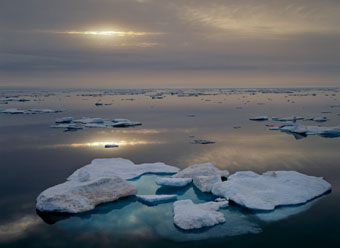
© Robert Glenn Ketchum
In the near term, the changing Arctic is requiring the Navy to review its readiness to operate in the high latitudes. As the Arctic continues to experience diminishing sea ice extent and volume in the summer months, the region will be more accessable for shipping, resource extraction from the sea bed, commercial fishing and tourism. Recent strategic guidance for the Defense Department requires the Navy and U.S. Coast Guard to review mission requirements in the high north. In order to determine what level of presence we will need, and when we will need it, we need a better assessment of the timeline for Arctic change.
Similarly, the Navy is concerned that rising seas will impact our infrastructure at coastal bases and place them more at risk to extreme storm surges. Thermal expansion of the warming ocean will result in a slow, deliberate rising of sea levels worldwide, but the increasingly rapid loss of land-locked ice in Greenland and Antarctica seems to be accelerating the process.
Task Force Climate Change was established by the Chief of Naval Operations, Admiral Gary Roughead, to examine the impact of global climate change on the Navy and maritime security, to identify potential challenges created by a changing climate on mission requirements, force structure and infrastructure, and to make recommendations to senior leadership on the way ahead. Another commitment we have is to ensure our recommendations are based upon the best and most current science.

U.S. Navy photo by Mass Communication Specialist 1st Class Tiffini M. Jones
Understanding and forecasting something as complex and dynamic as global climate change is a challenge beyond the capability of any single organization. Here again, partnerships will be essential. We need to be able to expand our environmental prediction capabilities from short-term operational timelines to strategic decadal timelines. A more reliable timeline of climate change will allow decision makers to more accurately assess future force and infrastructure requirements and inform investment decisions. But to do this, we will need a national sensing, data assimilation and processing strategy, the computational power of our greatest supercomputers and the intellectual partnership of our greatest minds.
The Navy is in discussion with the U.S. Air Force, the National Oceanic and Atmospheric Administration (NOAA), the National Aeronautics and Space Administration (NASA) and the Department of Energy towards that end. In September 2010, the Navy and NOAA co-hosted a meeting with multiple Federal offices and academic institutions that have environmental modeling assets to discuss a way ahead in this critical enterprise. Essential to its ultimate success will be the involvement of the Committee on Environment, Natural Resources and Sustainability, recently established by the White House Office of Science and Technology Policy to promote coordination and collaboration between government departments and agencies.
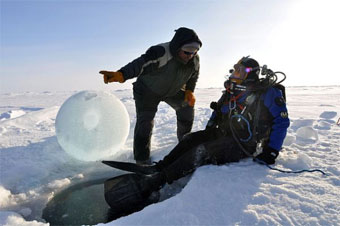
U.S. Navy photo by Mass Communication Specialist 1st Class Tiffini M. Jones
Climate change adaptation will require an investment in resources, which brings me to my final commitment – to ensure we are good stewards of taxpayer dollars. Both the U.S. Navy Arctic Roadmap (November 2009) and the U.S. Navy Climate Change Roadmap (May 2010) highlight the importance of partnerships. This includes cooperative actions with other Federal agencies, private organizations and other nations to leverage work already being done and to share the cost of climate change adaptation. Partnering with other Arctic nations will also allow us to learn from those navies more experienced in polar operations, and to share the responsibility for possible seach and rescue operations, oil spill mitigation and disaster relief efforts.
To ensure we are making responsible investments of taxpayer money, the Navy conducts capability-based assessments. These analyses vet future mission requirements against the capabilities that will be needed to accomplish those missions. This informs our investment strategies and ensures we are applying analytical rigor to our determinations. Capability-based assessments will provide recommendations for future investments at the right time and right cost. We must ensure we have the right capability on time, but we do not want to buy that capability ahead of need.
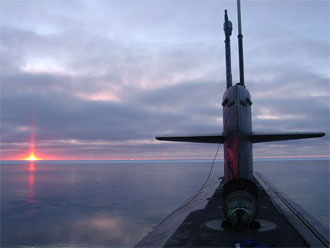
U.S. Navy photo by Chief Yeoman Alphonso Braggs
People caught in a crisis tend to open up their checkbooks and to start spending desperately. Before climate change is deemed a crisis to national security, we want to have studied it, evaluated our options and analytically determined the proper investments to make. It is our corporate commitment to ensure we make wise investments while remaining fully mission-capable.
For the U.S. Navy, mission-capable means having a globally-distributed forward presence to accomplish a wide range of missions that promote stability, prevent crises and combat terrorism. That forward presence allows us to regionally concentrate credible combat power to protect U.S. vital interests; assure our friends; and to deter, dissuade and, if necessary, defeat potential adversaries. In essence, the Navy-Marine Corps team is America’s first response to global contingencies, which is why Task Force Climate Change is an integral part of our commitment to America.
Roadmap 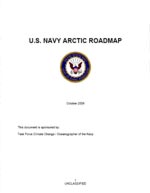 U.S. Navy Arctic Roadmap (1.03MB PDF) |
Roadmap 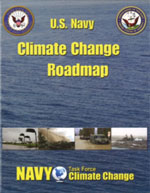 U.S. Navy Climate Change Roadmap (757KB PDF) |
|---|





























